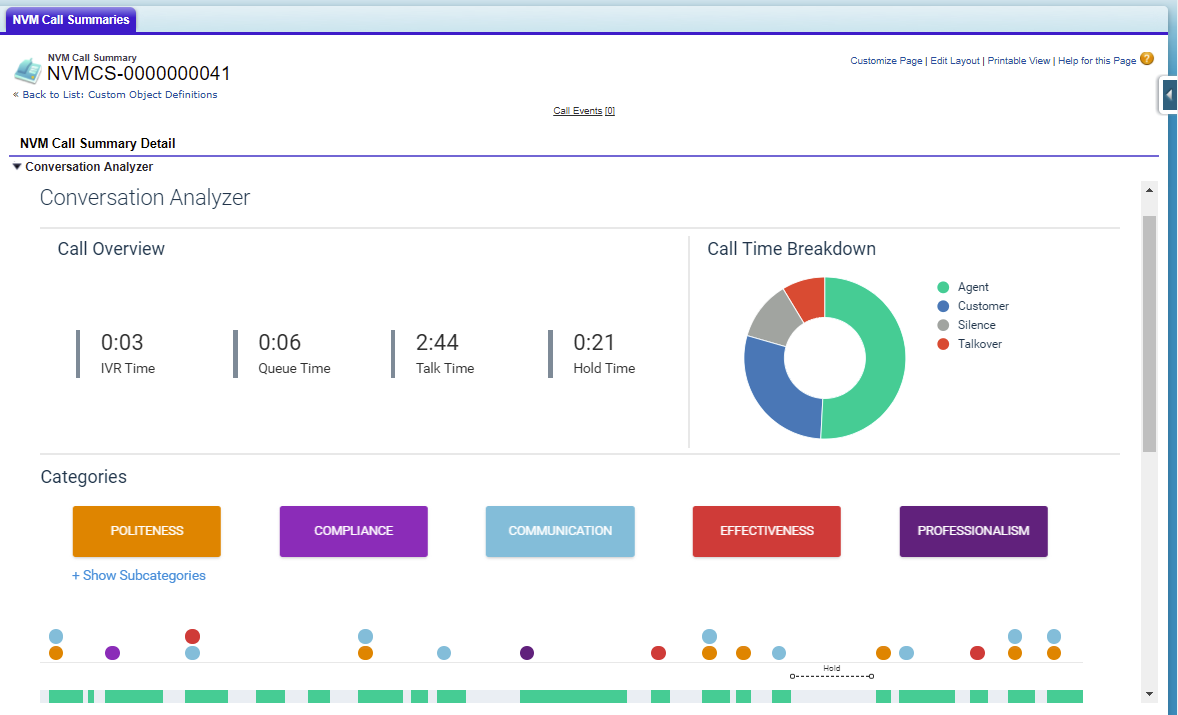If Advanced Reports and Statistics is enabled and configured for your account, you can use Conversation Analyzer in Salesforce,
Conversation Analyzer adds the following features to your Salesforce org:
If Conversation Analyzer is not enabled for your account, you can use call recording annotation. For information about configuring call recording annotation, see Configuring call recording annotation in Salesforce. |
If enabled for your account, to use Conversation Analyzer in Salesforce, you must perform various configuration tasks.
Before you can configure Conversation Analyzer in Salesforce, you must install and configure Advanced Reports and Statistics. For information about Advanced Reports and Statistics, see Advanced Reporting and Statistics in Salesforce.
To see the Conversation Analyzer components in NVM Call Summary records, change the page layout that the NVM Call Summary object uses:
The top section of the page layouts embeds Vonage Contact Center's Conversation Analyzer into an NVM Call Summary record. For information about the contents of the Conversation Analyzer, see Call Recordings.
Other sections on the page layouts are customized for the call type, containing only the fields that are relevant to those calls.
When you or an agent views a NVM Call Summary record, the Conversation Analyzer for the related call appears. You can see the Conversation Analyzer in the Conversation Analyzer section of the record.

As well as retrieving call summary and agent state statistics, Advanced Reporting and Statistics can retrieve call recording analytics data from Vonage Contact Center. Advanced Reporting and Statistics can also retrieve call recording transcripts. Advanced Reporting and Statistics stores the additional data in fields on the NVM Call Summary object.
To retrieve call recording analytics data or transcripts, or both, perform the following steps:
Locate and click NVM Advanced Reporting. NVM Advanced Reporting (Managed) appears.
Alongside Post Install Instructions, click View.
Fetch Analytics. Select the Fetch Analytics check box to retrieve and store the following data:
| Data to retrieve | Fields to store data in | Notes | |
|---|---|---|---|
| Category and subcategory data | Custom category and subcategory fields. Because you can customize categories and subcategories, you must create the fields yourself. For information, see 233856863.
| If you do not provide all related category and subcategory fields, Advanced Reporting and Statistics reports an error and does not retrieve applicable category and subcategory data. | |
| Percentage of agent talk time | Agent Percent (NVMStatsSF__Agent_Percent__c) | Fields appear in the Caller and Agent Related section. | |
| Percentage of talkover time | Crosstalk Percent (NVMStatsSF__Crosstalk_Percent__c) | ||
| Percentage of customer talk time | Customer Percent (NVMStatsSF__Customer_Percent__c) | ||
| Percentage of silence time | Silence Percent (NVMStatsSF__Silence_Percent__c) |
If you choose to retrieve call recording analytics data from Vonage Contact Center, you can create custom category and subcategory fields in which to store that data. (The Advanced Reporting and Statistics managed package provides custom fields to store other analytics data.) Each category and subcategory can have a corresponding field.
We recommend that you create a custom checkbox field for each category and a number field for each subcategory that you have configured for the Conversation Analyzer feature. Set Field Name—as referenced by APIs—for the fields using the following format:
Set Default Value for the field to Unchecked for the category check boxes and 0 for the subcategory number fields. The values you specify in Field Name fields are case-insensitive. Field Name values must be a case-insensitive match for the category and subcategory names as configured in Vonage Contact Center. Where spaces and other nonalphanumeric characters appear in the names used in Vonage Contact Center, replace such characters with an underscore (_) character. Advanced Reporting and Statistics do not support names with two consecutive underscores, and names are subject to the length limit for Field Name values in Salesforce. For information about field names in Salesforce, see Salesforce help. Salesforce appends the __c to Field Name indicating that this is a custom field. Field Label values, which appear in records and on reports, do not need to match a specified format, but we recommend that you align them to the Field Name values. |
For example, if you have a Communication category and an Active listening subcategory, create fields with the following types, labels, names, and default values:
| Category/subcategory | Type | Field type | Field Label | Field Name | Default Value |
|---|---|---|---|---|---|
| Communication | Category | Checkbox | Communication | Communication__c | Unchecked |
| Active listening | Subcategory | Number | Active listening | Communication_Active_listening__c | 0 |
Optionally, create a section on the summary page layouts and add the category and subcategory custom fields.
Next time a transaction runs, Advanced Reporting and Statistics retrieves category and subcategory data and populates custom fields as appropriate. A checked field indicates that the transcript of the call recording matched the category or subcategory.
